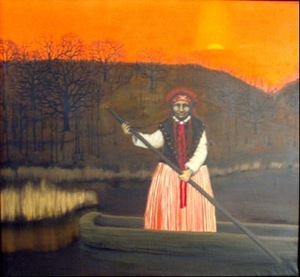SHAMAN RITUALS IN THE SAMOGITIAN CLOTHING 0
In brief: The large-scale exhibition ‘Mirabile Visu’ (Wonderful to See) at Mykolas Žilinskas Art Gallery in Kaunas favours the sight and mind and allows to acknowledge the space anew. The curators of the show reveal the museum as a historical exhibit continuous in time and present the retrospective of its formation.
Amongst a broad variety of images one may find ‘The Samogitian Woman’ by the painter Elena Kniūkštaitė. Indeed, a large format and burning colouring of the work draws the attention. An intensive red sky matches the fabric of the national costume. Shadowy waters stretch further to the hill overgrown with trees. Red colour represents threat and danger but the Samogitian woman – static and calm, stocky and stable – withstands the tension of colours.
Paradoxically, the lonely but tenacious granny as if becomes a personification of the whole exhibition. The stoic and stubborn Samogitian must have had a cheerful youth, survived all the troubles of life and finally accepted the life without fear. The museum also experienced its youth communicating with world-famous artists, covering government-unfriendly works of art during the Soviet era and letting in fresh, contemporary air in our days.
Human senses are affected through colours, spaces and dimensions in the picture. Two depths – those of sky and water – threaten to confront in the silence of nature. The first one drowns us in the underworld and darkens the eyes; the second one shows a dazzling way to heaven and salvation. The Samogitian woman is, arguably, the Lithuanian version of Charon waiting in the waters of Styx or a shaman keeping harmony and peace in the world. Her face and headdress do resemble those of a shaman waiting quietly disorders of world to pass and a peaceful state to return. Such associations strengthen the magical atmosphere of the picture. Its title and costume of the depicted woman suggest an ethnographic element yet ethnography is not restricted to costumes. The author manipulates archetypical meanings and symbols; the picture starts to reflect folk mystique.
A smooth manner of painting too gives mystique and magic to ‘The Samogitian Woman’ and elements painted in sfumato (line of coast, bulrush in the water) create the impression of vibration and mystery. Nature depicted in seemingly flat and static work acquires elemental vitality, mysteriousness; everything starts to move and ripple.
The search and sensations of the artist lead one towards the aesthetics of naïve art – the modernist art movement raising interests in folk art, primitive prototypes and exotic cultures. E. Kniūkštaitė does not aspire after precise naturalism – the face of the Samogitian is abstracted, impersonal, resembling of folk wood carving. An exotic element is involved – associations and references to a Native American or shaman. A superstitious mysticism is felt here; the author rethinks human existence and the significance of stability in life through archetypical natural elements. She invites to stop and turn back to traditions.
The work of E. Kniūkštaitė stimulates meditatively and philosophically. The calm and thoughtful old Samogitian seem to be very familiar yet the inner atmosphere of the picture vibrates and takes us to distant lands, unknown steppes where shamans perform their rituals. That is how the painter’s personal magic begins: the author is able to displace the viewer to other spaces and existences without leaving one’s own ‘I’ and well-known spaces.

